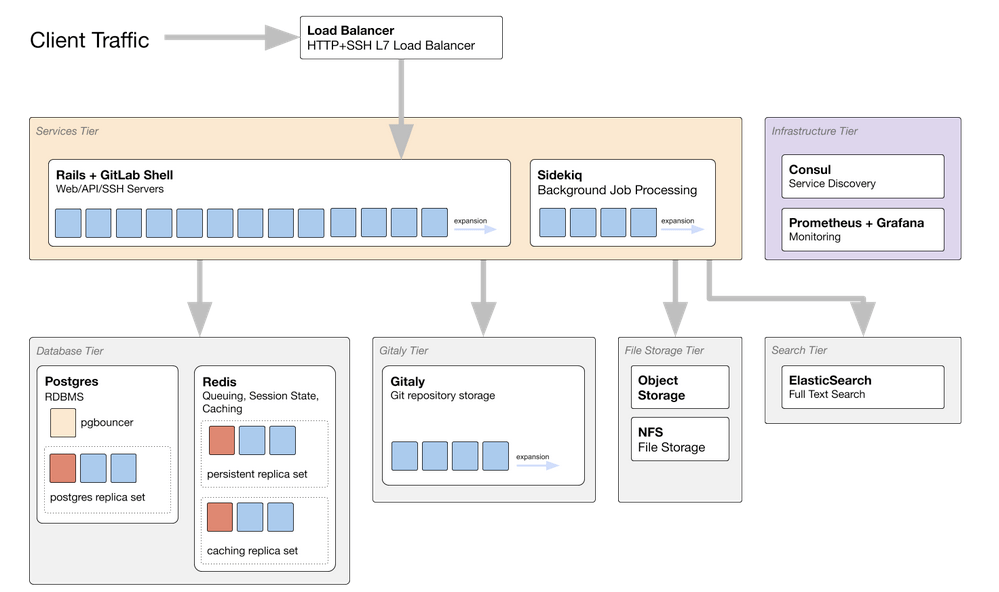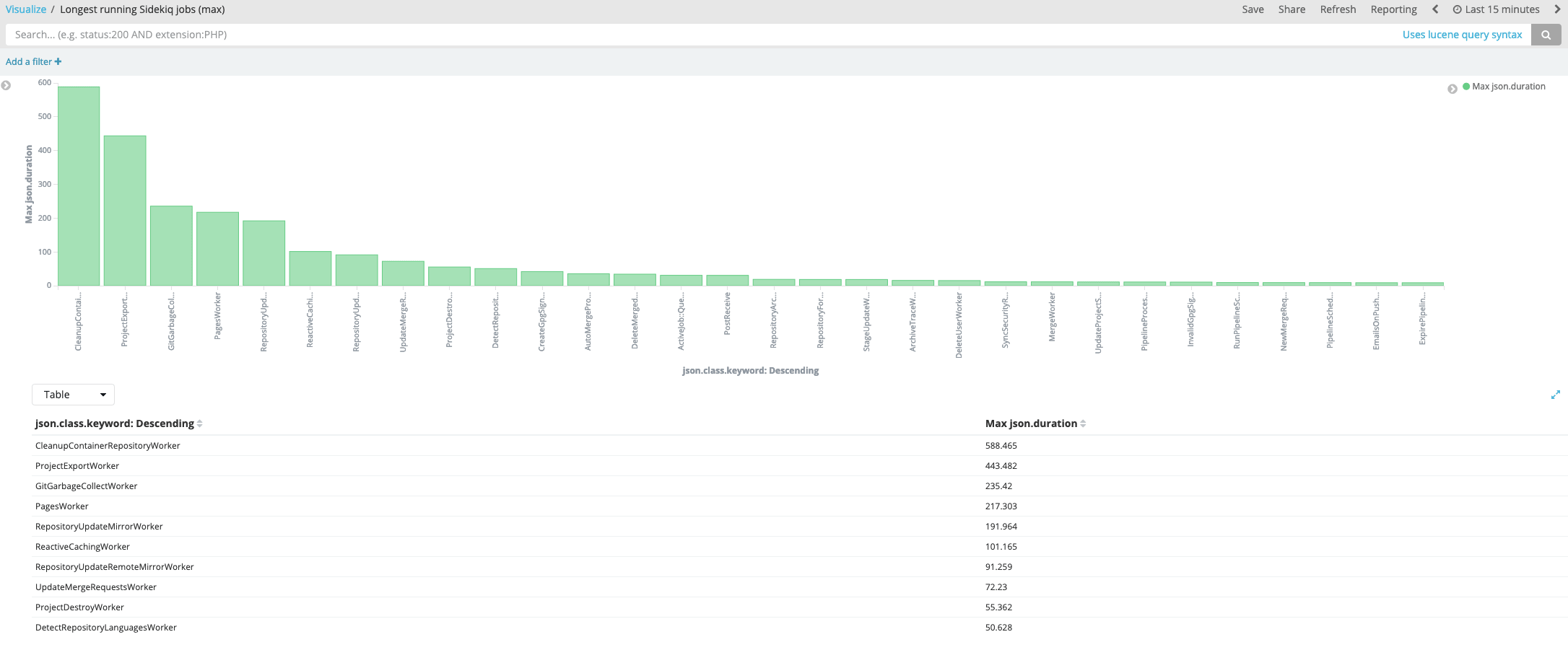13 KiB
| stage | group | info |
|---|---|---|
| none | unassigned | To determine the technical writer assigned to the Stage/Group associated with this page, see https://about.gitlab.com/handbook/engineering/ux/technical-writing/#designated-technical-writers |
GitLab scalability
This section describes the current architecture of GitLab as it relates to scalability and reliability.
Reference Architecture Overview
diagram source - GitLab employees only
The diagram above shows a GitLab reference architecture scaled up for 50,000 users. We will discuss each component below.
Components
PostgreSQL
The PostgreSQL database holds all metadata for projects, issues, merge requests, users, etc. The schema is managed by the Rails application db/structure.sql.
GitLab Web/API servers and Sidekiq nodes talk directly to the database via a Rails object relational model (ORM). Most SQL queries are accessed via this ORM, although some custom SQL is also written for performance or for exploiting advanced PostgreSQL features (e.g. recursive CTEs, LATERAL JOINs, etc.).
The application has a tight coupling to the database schema. When the application starts, Rails queries the database schema, caching the tables and column types for the data requested. Because of this schema cache, dropping a column or table while the application is running can produce 500 errors to the user. This is why we have a process for dropping columns and other no-downtime changes.
Multi-tenancy
A single database is used to store all customer data. Each user can belong to many groups or projects, and the access level (e.g. guest, developer, maintainer, etc.) to groups and projects determines what users can see and what they can access.
Users with admin access can access all projects and even impersonate users.
Sharding and partitioning
The database is not divided up in any way; currently all data lives in one database in many different tables. This works for simple applications, but as the data set grows, it becomes more challenging to maintain and support one database with tables with many rows.
There are two ways to deal with this:
- Partitioning. Locally split up tables data.
- Sharding. Distribute data across multiple databases.
Partitioning is a built-in PostgreSQL feature and requires minimal changes in the application. However, it requires PostgreSQL 11.
For example, a natural way to partition is to partition tables by
dates. For example,
the events and audit_events table are natural candidates for this
kind of partitioning.
Sharding is likely more difficult and will require significant changes to the schema and application. For example, if we have to store projects in many different databases, we immediately run into the question, "How can we retrieve data across different projects?" One answer to this is to abstract data access into API calls that abstract the database from the application, but this is a significant amount of work.
There are solutions that may help abstract the sharding to some extent from the application. For example, we will want to look at Citus Data closely. Citus Data provides a Rails plugin that adds a tenant ID to ActiveRecord models.
Sharding can also be done based on feature verticals. This is the microservice approach to sharding, where each service represents a bounded context and operates on its own service-specific database cluster. In that model data wouldn't be distributed according to some internal key (such as tenant IDs) but based on team and product ownership. It shares a lot of challenges with traditional, data-oriented sharding, however. For instance, joining data has to happen in the application itself rather than on the query layer (although additional layers like GraphQL might mitigate that) and it requires true parallelism to run efficiently (i.e. a scatter-gather model to collect, then zip up data records), which is a challenge in itself in Ruby based systems.
Database size
A recent database checkup shows a breakdown of the table sizes on
GitLab.com.
Since merge_request_diff_files contains over 1 TB of data, we will want to
reduce/eliminate this table first. GitLab has support for storing diffs in
object storage, which we will
want to do on
GitLab.com.
High availability
There are several strategies to provide high-availability and redundancy:
- Write-ahead logs (WAL) streamed to object storage (e.g. S3, Google Cloud Storage).
- Read-replicas (hot backups).
- Delayed replicas.
To restore a database from a point in time, a base backup needs to have been taken prior to that incident. Once a database has restored from that backup, the database can apply the WAL logs in order until the database has reached the target time.
On GitLab.com, Consul and Patroni work together to coordinate failovers with the read replicas. Omnibus ships with both repmgr and Patroni.
Load-balancing
GitLab EE has application support for load balancing using read replicas. This load balancer does some smart things that are not traditionally available in standard load balancers. For example, the application will only consider a replica if its replication lag is low (e.g. WAL data behind by < 100 megabytes).
More details are in a blog post.
PgBouncer
As PostgreSQL forks a backend process for each request, PostgreSQL has a finite limit of connections that it can support, typically around 300 by default. Without a connection pooler like PgBouncer, it's quite possible to hit connection limits. Once the limits are reached, then GitLab will generate errors or slow down as it waits for a connection to be available.
High availability
PgBouncer is a single-threaded process. Under heavy traffic, PgBouncer can saturate a single core, which can result in slower response times for background job and/or Web requests. There are two ways to address this limitation:
- Run multiple PgBouncer instances.
- Use a multi-threaded connection pooler (e.g. Odyssey.
On some Linux systems, it's possible to run multiple PgBouncer instances on the same port.
On GitLab.com, we run multiple PgBouncer instances on different ports to avoid saturating a single core.
In addition, the PgBouncer instances that communicate with the primary and secondaries are set up a bit differently:
- Multiple PgBouncer instances in different availability zones talk to the PostgreSQL primary.
- Multiple PgBouncer processes are colocated with PostgreSQL read replicas.
For replicas, colocating is advantageous because it reduces network hops and hence latency. However, for the primary, colocating is disadvantageous because PgBouncer would become a single point of failure and cause errors. When a failover occurs, one of two things could happen:
- The primary disappears from the network.
- The primary becomes a replica.
In the first case, if PgBouncer is colocated with the primary, database connections would time out or fail to connect, and downtime would occur. Having multiple PgBouncer instances in front of a load balancer talking to the primary can mitigate this.
In the second case, existing connections to the newly-demoted replica may execute a write query, which would fail. During a failover, it may be advantageous to shut down the PgBouncer talking to the primary to ensure no more traffic arrives for it. The alternative would be to make the application aware of the failover event and terminate its connections gracefully.
Redis
There are three ways Redis is used in GitLab:
- Queues. Sidekiq jobs marshal jobs into JSON payloads.
- Persistent state. Session data, exclusive leases, etc.
- Cache. Repository data (e.g. Branch and tag names), view partials, etc.
For GitLab instances running at scale, splitting Redis usage into separate Redis clusters helps for two reasons:
- Each has different persistence requirements.
- Load isolation.
For example, the cache instance can behave like an least-recently used
(LRU) cache by setting the maxmemory configuration option. That option
should not be set for the queues or persistent clusters because data
would be evicted from memory at random times. This would cause jobs to
be dropped on the floor, which would cause many problems (e.g. merges
not running, builds not updating, etc.).
Sidekiq also polls its queues quite frequently, and this activity can slow down other queries. For this reason, having a dedicated Redis cluster for Sidekiq can help improve performance and reduce load on the Redis process.
High availability/Risks
Single-core: Like PgBouncer, a single Redis process can only use one core. It does not support multi-threading.
Dumb secondaries: Redis secondaries (aka replicas) don't actually handle any load. Unlike PostgreSQL secondaries, they don't even serve read queries. They simply replicate data from the primary and take over only when the primary fails.
Redis Sentinels
Redis Sentinel provides high availability for Redis by watching the primary. If multiple Sentinels detect that the primary has gone away, the Sentinels performs an election to determine a new leader.
Failure Modes
No leader: A Redis cluster can get into a mode where there are no
primaries. For example, this can happen if Redis nodes are misconfigured
to follow the wrong node. Sometimes this requires forcing one node to
become a primary via the REPLICAOF NO ONE
command.
Sidekiq
Sidekiq is a multi-threaded, background job processing system used in Ruby on Rails applications. In GitLab, Sidekiq performs the heavy lifting of many activities, including:
- Updating merge requests after a push.
- Sending e-mails.
- Updating user authorizations.
- Processing CI builds and pipelines.
The full list of jobs can be found in the
app/workers
and
ee/app/workers
directories in the GitLab code base.
Runaway Queues
As jobs are added to the Sidekiq queue, Sidekiq worker threads need to pull these jobs from the queue and finish them at a rate faster than they are added. When an imbalance occurs (e.g. delays in the database, slow jobs, etc.), Sidekiq queues can balloon and lead to runaway queues.
In recent months, many of these queues have ballooned due to delays in PostgreSQL, PgBouncer, and Redis. For example, PgBouncer saturation can cause jobs to wait a few seconds before obtaining a database connection, which can cascade into a large slowdown. Optimizing these basic interconnections comes first.
However, there are a number of strategies to ensure queues get drained in a timely manner:
- Add more processing capacity. This can be done by spinning up more instances of Sidekiq or Sidekiq Cluster.
- Split jobs into smaller units of work. For example,
PostReceiveused to process each commit message in the push, but now it farms out this toProcessCommitWorker. - Redistribute/gerrymander Sidekiq processes by queue types. Long-running jobs (e.g. relating to project import) can often squeeze out jobs that run fast (e.g. delivering e-mail). This technique was used in to optimize our existing Sidekiq deployment.
- Optimize jobs. Eliminating unnecessary work, reducing network calls (e.g. SQL, Gitaly, etc.), and optimizing processor time can yield significant benefits.
From the Sidekiq logs, it's possible to see which jobs run the most frequently and/or take the longest. For example, these Kibana visualizations show the jobs that consume the most total time:
visualization source - GitLab employees only
This shows the jobs that had the longest durations:


